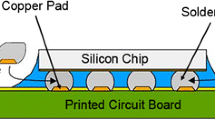The most recent observations of the response of bulk samples of several commercial solder alloys, exposed to temperatures below the allotropic transition for tin (13°C) for extended periods, are reported. Damage associated with tin pest development has been arbitrarily graded into six levels, and the formation of visible α-phase warts used for comparative purposes. Since the previous examination, some 2 years ago, tin pest has been observed for the first time in the traditional Sn-37Pb solder alloy after exposure at −18°C and −40°C, and actual warts were apparent in as-cast Sn-0.5Cu stored at −40°C and in as-cast Sn-3.5Ag after exposure at −18°C. No tin pest was detected in Sn-Zn-3Bi after exposure for periods up to 6 years. Tin pest continued to develop in those lead-free alloys in which it had previously been observed, indicating the probability that all would eventually disintegrate in time. In general, prior thermal or mechanical treatment accentuated tin pest formation. The influence of exposure temperature was unclear, since some alloys (Sn-0.5Cu and Sn-3.8Ag-0.7Cu) experienced more damage at −18°C, but others (Sn-37Pb and Sn-3.5Ag) were more susceptible at −40°C. From a consideration of the findings and other published information, it is contended that impurity levels below 0.1 mass% (1000 ppm) play a vital role in determining whether tin pest develops in realistic timescales. A major factor in the absence of tin pest, to date, on actual joints may be simply the mismatch between the timescales experienced in service and those in long-duration laboratory tests.
Similar content being viewed by others
References
W.J. Plumbridge, J. Mater. Sci. Mater. Electron. 18, 307 (2007).
J.H. Becker, J. Appl. Phys. 29, 7 (1958).
A.D. Styrkas, Inorg. Mater. 39, 806 (2003).
A. Bornemann (Symposium on Solder, ASTM STP 189, Philadelphia, 1956), p. 129
W.L. Williams (Symposium on Solder, ASTM STP 189, Philadelphia, 1956), p. 149
Y. Kariya, N. Williams, C.R. Gagg, and W.J. Plumbridge, J. Mater. 53, 39 (2001).
Y. Kariya, C.R. Gagg, and W.J. Plumbridge, Solder. Surf. Mount Technol. 13, 39 (2001).
W.J. Plumbridge, J. Electron. Mater. 37, 218 (2008).
M. Leodolter-Dworak, I. Steffan, W.J. Plumbridge, and H. Ipser, J. Electron. Mater. 39, 105 (2010).
D. Di Maio and C. Hunt, J. Electron. Mater. 38, 1874 (2009).
K. Sweatman, S. Suenaga, and T. Nishimura, IPC/JEDEC Eigth Int. Conf. on Lead-free Electronic Components and Assemblies, San Jose, April (2005)
D. Di Maio and C. Hunt, Mater. Electron. 20, 386 (2009).
L. Snugovsky, C. Cermignani, D.D. Petrovic, and J. Rutter, J. Electron. Mater. 33, 1313 (2004).
L. Snugovsky, P. Snugovsky, D.D. Petrovic, and J. Rutter, Mater. Sci. Technol. 21, 61 (2005).
A.A. Matvienko and A.A. Sidelnikov, J. Alloy Compd. 252, 172 (1997).
X.W. Liu and W.J. Plumbridge, J. Electron. Mater. 32, 278 (2003).
Author information
Authors and Affiliations
Corresponding author
Rights and permissions
About this article
Cite this article
Plumbridge, W. Further Observations on Tin Pest Formation in Solder Alloys. J. Electron. Mater. 39, 433–440 (2010). https://doi.org/10.1007/s11664-010-1104-9
Received:
Accepted:
Published:
Issue Date:
DOI: https://doi.org/10.1007/s11664-010-1104-9



